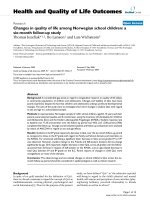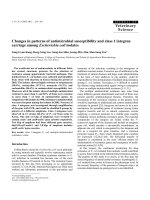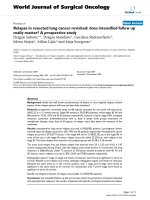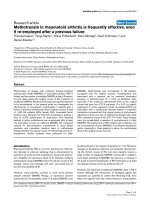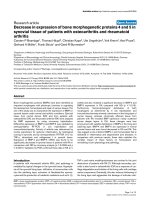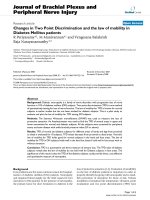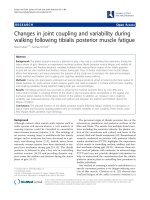Báo cáo y học: "Changes in S-100 protein serum levels in survivors of out-of-hospital cardiac arrest treated with mild therapeutic hypothermia: a prospective, observational study" potx
Bạn đang xem bản rút gọn của tài liệu. Xem và tải ngay bản đầy đủ của tài liệu tại đây (250.27 KB, 7 trang )
Open Access
Available online />Page 1 of 7
(page number not for citation purposes)
Vol 13 No 2
Research
Changes in S-100 protein serum levels in survivors of
out-of-hospital cardiac arrest treated with mild therapeutic
hypothermia: a prospective, observational study
Matthias Derwall
1,2
, Christian Stoppe
1
, David Brücken
1
, Rolf Rossaint
1
and Michael Fries
1
1
Department of Anaesthesiology, University Hospital RWTH Aachen, Pauwelsstrasse 30, 52074 Aachen, Germany
2
Institute of Neuropathology, University Hospital RWTH Aachen, Pauwelsstrasse 30, 52074 Aachen, Germany
Corresponding author: Matthias Derwall,
Received: 15 Jan 2009 Revisions requested: 11 Mar 2009 Revisions received: 19 Mar 2009 Accepted: 16 Apr 2009 Published: 16 Apr 2009
Critical Care 2009, 13:R58 (doi:10.1186/cc7785)
This article is online at: />© 2009 Derwall et al.; licensee BioMed Central Ltd.
This is an open access article distributed under the terms of the Creative Commons Attribution License ( />),
which permits unrestricted use, distribution, and reproduction in any medium, provided the original work is properly cited.
Abstract
Introduction Knowledge about the influence of current
neuroprotective interventions on prognostic markers after
survival from cardiac arrest is lacking. This study aimed to
investigate the effects of mild therapeutic hypothermia on the
release of the astroglial protein S-100 after cardiopulmonary
resuscitation (CPR) in survivors of out-of-hospital cardiac arrest.
Methods This was a prospective, observational study
performed during a two-year period, involving medical
emergency services and five collaborating hospitals at the city of
Aachen, Germany. Sixty-eight subjects were enrolled by the
emergency physician on duty by taking blood samples after
successful attempts at resuscitation with return of spontaneous
circulation (ROSC), followed by samples at 6, 12, 24, 72 and
120 hours post ROSC by the appropriate intensive care unit
staff. Depending on the decision of the attending physician,
subjects were cooled down to 33°C (n = 37) for 24 hours or
were held at 37°C (n = 31). Patients were tracked for estimating
mortality and gross neurological outcome for 14 days.
Results S-100 levels in patients not receiving mild therapeutic
hypothermia (normothermia (NT)) showed equivalent numbers
as compared with cooled patients (mild therapeutic hypothermia
(MTH)) on baseline (NT = 1.38 μg/l versus MTH = 1.30 μg/l; P
= 0.886). S-100 levels on baseline were significantly lower in
patients with a good neurological outcome at 14 days after the
event in comparison to their peers with adverse outcome (P =
0.014). Although the difference in S-100 levels of MTH patients
with adverse or favourable neurological outcome reached
statistical significance, it did not in NT patients.
Conclusions Although the predictive power of S-100 levels
were best on admission but not at later time points, MTH had no
influence on S-100 serum levels in survivors of non-traumatic
out-of-hospital cardiac arrest in the particular setting of this
investigation.
Introduction
Sudden cardiac arrest (SCA) is the leading cause of death in
the USA and Europe affecting about 750,000 people annually
[1,2]. Because of improved public training of cardiopulmonary
resuscitation (CPR) and advances in professional emergency
medical response [3], the rate of return of spontaneous circu-
lation (ROSC) has risen in the past decades. However,
depending on the duration of the arrest, neurological survival
is still a major concern [4]. The application of mild therapeutic
hypothermia (MTH) has been demonstrated to significantly
reduce neurological damage in survivors of SCA in two ran-
domised controlled trials [5,6].
Clinically, it is desirable to rely on an early and specific marker
for final neurological outcome. Protein S-100B is a potential
candidate for estimating post hypoxic neuronal damage due to
its neuronal specificity and characteristic behaviour in serum
depending on the degree of damage to the central nervous
system (CNS) [7-16]. Increased serum levels of S-100 also
have prognostic value for unfavourable neurological outcomes
BBB: blood-brain barrier; CPR: cardiopulmonary resuscitation; CNS: central nervous system; CPC: cerebral performance categories; HR: heart rate;
MAP: mean arterial pressure; MTH: mild therapeutic hypothermia; NT: normothermia; ROSC: return of spontaneous circulation; SCA: sudden cardiac
arrest; VF: ventricular fibrillation.
Critical Care Vol 13 No 2 Derwall et al.
Page 2 of 7
(page number not for citation purposes)
in patients with traumatic brain injury, stroke and cardiac sur-
gery [17-20]. Several studies have investigated its potential
role as a prognostic marker in survivors of SCA and found it to
be a reliable marker for hypoxic/ischaemic CNS damage
[8,11,13,14,21,22]. The progressive implementation of MTH
into clinical practice and its proven impact on neurological out-
come has raised the question about its influence on serum lev-
els of S-100.
The present study was therefore conducted to elucidate the
influence of MTH on S-100 serum levels in survivors of non-
traumatic out-of-hospital cardiac arrest.
Materials and methods
During a two-year period from 2005 to 2007, 68 patients
(aged over 18 years) suffering from non-traumatic out-of-hos-
pital cardiac arrest were included in this prospective study.
Severe pre-existing conditions diagnosed in the past six
months including sepsis, stroke, previous CPR and cancer
were regarded as exclusion criteria.
CPR was performed in accordance to European Resuscitation
Council's guidelines for advanced life support 2000 [23],
which were gradually replaced by the 2005 edition [24] during
the investigation period. In general, professional emergency
medical technicians were supervised by an emergency physi-
cian on scene.
Demographic and CPR-related data were collected at the
emergency department immediately after hospital admission
and after 6, 12, 24, 72 and 120 hours at the intensive care unit
via a web-based data entry system using an Utstein-Style like
template, introduced by the German Society of Anaesthesiol-
ogy and Intensive Care Medicine [25]. Hospital admission and
first withdrawal of blood was defined as baseline.
At corresponding time points, information about haemody-
namic and metabolic parameters, such as heart rate (HR),
mean arterial pressure (MAP) and lactate and glucose levels,
as well as the proof of microbiological pathogens and whether
catecholamines were used or not, were documented. Data
about the time when MTH was started and how long MTH was
maintained were also collected. The decision to initiate MTH
was solely at the discretion of the attending physician.
At day 14, neurological outcome was assessed using the cer-
ebral performance categories (CPC) by a physician unaware
of the study. CPC 1 and 2 were regarded as favourable neu-
rological outcome, whereas CPC 3 to 5 signified adverse out-
come [26].
Because all personal data were kept anonymous and no addi-
tional blood samples were taken, the local ethics committee
approved the study without the requirement to obtain informed
consent from each patient.
Patients received standardised intensive care treatment
including mechanical ventilation, tight glucose control, infec-
tion control and vasopressor treatment to maintain MAP above
65 mmHg. Additional interventions, such as heart catheterisa-
tion, were performed if necessary.
If it was decided to cool the patient, no active warming was
applied before induction of MTH. Hypothermia was induced
via infusion of one to two litres of cold (about 6°C) saline in
combination with body surface cooling using bags filled with
ice water. To avoid shivering, patients received a continuous
intravenous infusion of non-depolarising neuromuscular-block-
ing drugs such as rocuronium or pancuronium. Although no
specific instructions were supplied by the study protocol, the
vast majority of patients nevertheless received a combined
continuous infusion of either midazolam or propofol and an
opioid. Caregivers were advised to cool down patients as fast
as possible in the induction period and to aim to achieve a core
temperature of 33°C for 24 hours and to rewarm the patient
carefully, not exceeding 1°C per hour. Core temperature was
measured with an oesophageal temperature probe, and
rewarming was usually performed with a convecting heating
blanket.
Serum samples for the determination of S-100 protein were
taken from the supernatant of blood collected for routine labo-
ratory analyses and stored at -80°C for later analysis. Serum
levels were quantified using a commercially available auto-
mated system (LIAison, DiaSorin, Dietzenbach, Germany).
To detect influences of MTH on S-100 protein levels at the
given time points, patients were grouped into those receiving
MTH or normothermia (NT). In a second analysis, this data
were evaluated regarding differences in the final CPC scores,
that is, favourable vs. adverse neurological outcome, as
defined above. Data were analysed using statistical software
SPSS 14.0 (SPSS Inc., Chicago, IL, USA). All results are
expressed as mean ± standard deviation. To establish differ-
ences between groups, analysis of variance was performed
and corrected for multiple comparisons (Bonferroni) in the
case of continuous variables. To detect changes over time,
repeated measures analysis of variance was employed and fol-
lowed by pairwise t-tests. Categorical data were analysed
using chi-squared test. P < 0.05 was considered to indicate
statistical significance.
Results
No differences between patients treated with or without MTH
were found with regard to most of the demographic and arrest-
related data (Table 1). Patients treated with MTH were signifi-
cantly more prone to bacterial infection and more often
required catecholamines. Nevertheless, these patients also
tended to have a higher in-hospital survival rate (MTH = 78.4%
vs. NT = 54.8%; P = 0.067) accompanied by a slightly more
favourable neurological outcome in comparison with the NT
Available online />Page 3 of 7
(page number not for citation purposes)
group (CPC ≤ 2: MTH = 56.8% vs. NT = 45.2%; P = 0.341).
Grossly, haemodynamic and metabolic changes were compa-
rable between groups (Data not shown).
Patients treated with MTH had significantly lower oesophageal
temperatures already at baseline when compared with NT
patients (35.5°C vs. 36.4°C; P = 0.011). The target tempera-
ture of 34°C was reached within 3.0 ± 2.2 hours after hospital
admission and was maintained for 24.8 ± 4.9 hours. Lowest
values were recorded 12 hours after baseline, with mean val-
ues of 33.4 ± 0.8°C. NT patients developed sub-febrile tem-
peratures with a peak of 37.9°C at 12 hours post resuscitation
(Figure 1).
S-100 levels at baseline were significantly elevated in patients
with adverse neurological outcome (P = 0.014). This was also
true after 24 and 72 hours (Table 2).
There were no significant differences in S-100 serum levels
between NT and MTH patients at any time point (Figure 2).
Regardless of neurological outcome, S-100 serum levels were
almost congruent from six hours after ROSC in NT patients as
depicted in Figure 3. In contrast, patients treated with MTH
and a favourable neurological outcome showed a strong trend
to lower S-100 serum levels being significant after 24 hours
(CPC 1 to 2 = 0.56 vs. CPC 3 to 5 = 0.24; P = 0.001; Figure
4).
Table 1
Demographical and clinical variables of patients treated with mild therapeutic hypothermia (MTH) or normothermia (NT)
MTH (n = 37) NT (n = 31) P
Age, years 62.6 ± 15.7 67.1 ± 14.0 0.229
Sex, % male 64.7 74.2 0.442
Survival time, hours 120 ± 42 115 ± 24 0.914
Survivors, % 78.4 54.8 0.067
Good neurological outcome, % 56.8 45.2 0.341
Call-response-interval, min:sec 03:19 ± 02:26 03:05 ± 01:57 0.660
Total adrenaline, mg 4.3 ± 3.8 3.2 ± 3.8 0.286
Total shocks, n 3.5 ± 2.6 3.8 ± 5.7 0.760
Arrest witnessed, % 40.5 51.6 0.411
Initial rhythm VF, % 66.7 51.6 0.220
Cardiac origin of arrest, % 91.9 64.5 0.052
Proof of any pathogen, %* 67.6 12.9 0.001
Catecholamines at any time, %* 97.3 71.0 0.002
Core temperature at BL, °C* 35.5 36.4 0.011
Glasgow coma scale at BL 3 ± 2 4 ± 3 0.339
Results presented as mean ± standard deviation. * P < 0.05 MTH vs. NT. BL = baseline; VF = ventricular fibrillation.
Figure 1
Time course of patient's oesophageal temperatureTime course of patient's oesophageal temperature. * P < 0.05 for mild
therapeutic hypothermia vs. normothermia. BL = baseline.
Critical Care Vol 13 No 2 Derwall et al.
Page 4 of 7
(page number not for citation purposes)
Discussion
In the present study the administration of MTH did not signifi-
cantly influence serum levels of S-100 protein in patients sur-
viving non-traumatic out-of-hospital cardiac arrest. Both
patients treated with or without MTH showed comparable
decreases in S-100 serum levels over time (Figure 2). These
findings were only marginally different when patients were
stratified according to the final neurological outcome.
S-100 protein is an astrocyte-derived neurotrophic protein
which is strongly associated with the promotion of neuronal
growth and survival [27]. It is predominately found in astro-
Table 2
S-100 Serum levels on each timepoint
Timepoint Neurological outcome P value
Good (CPC 1 to 2) Bad (CPC 3 to 5)
BL* 0.81 ± 1.09 1.93 ± 1.78 0.028
6 hours 0.47 ± 0.45 0.71 ± 0.67 0.192
12 hours 0.37 ± 0.39 0.57 ± 0.53 0.166
24 hours* 0.27 ± 0.22 0.51 ± 0.31 0.002
72 hours* 0.21 ± 0.15 0.41 ± 0.40 0.030
120 hours 0.17 ± 0.09 0.19 ± 0.10 0.669
Results presented as mean ± standard deviation. * P < 0.05 cerebral
performance categories (CPC) 1 to 2 vs. CPC 3 to 5. BL = baseline.
Figure 2
Time course of S-100 proteinTime course of S-100 protein. S-100 protein serum levels in patients
receiving mild therapeutic hypothermia (MTH) vs. normothermia (NT).
BL = baseline.
Figure 3
S-100 time course – normothermiaS-100 time course – normothermia. S-100 serum levels in patients (n =
31) receiving normothermia (NT) for cerebral performance categories
(CPC) 1 to 2 vs. 3 to 5. BL = baseline.
Figure 4
S-100 time course – mild therapeutic hypothermiaS-100 time course – mild therapeutic hypothermia. S-100 serum levels
in patients (n = 37) receiving mild therapeutic hypothermia (MTH). * P
< 0.05 for cerebral performance categories (CPC) 1 to 2 vs. 3 to 5. BL
= baseline.
Available online />Page 5 of 7
(page number not for citation purposes)
cytes and Schwann cells [28] and may play a crucial role in the
process of learning and memory [29]. Due to its molecular
weight of 21,000 Dalton, S-100B may only be detected in
peripheral blood if the integrity of the blood-brain barrier
(BBB) is disrupted. On the other hand, a specific lesion to the
BBB not involving the CNS may also result in elevated serum
levels [30]. Rises in S-100 serum levels are also reported from
extracerebral tissues such as marrow, fat or muscle [31].
Despite its obvious lack of specificity, it has nevertheless been
found to be an early and sensitive marker of hypoxic brain dam-
age and short-term outcome after cardiac arrest [8,10,11,13-
16,19]. Our study is in accordance with these previous reports
as at several time points patients with bad neurological out-
come had significantly higher serum levels in S-100 protein.
Remarkably, the prognostic value of S-100 for neurological
outcome in this study diminished over time. Therefore, the ini-
tial measurement shortly after admission to the hospital was
the most valuable within the post-resuscitation period.
Two previous studies have focused on the effect of therapeu-
tic hypothermia on levels of serum S-100B protein in survivors
of cardiac arrest [32,33]. Although Hachimi-Idrissi and col-
leagues [32] observed a mixed population of patients with
asystole and ventricular fibrillation (VF), the study by Tiainen
and colleagues [33] only included patients with VF, which did
not reveal a significant decline of S-100B values in MTH
patients. In contrast, Hachimi-Idrissi and colleagues found a
significant decline in MTH patients as compared with NT treat-
ment [32]. The decline was even more pronounced in patients
with asystole as initial rhythm. Because patients in our investi-
gation predominantly presented with VF as initial rhythm
(66.7% in MTH vs 51.6% in NT) our results seem to support
the notion of a connection between initial ECG and the influ-
ence of MTH on this surrogate marker.
Although we recognised a trend towards higher survival rates
as well as improved neurological outcome, we did not detect
significant improvements of these two important endpoints in
this investigation which contrasts the findings from previous
larger studies. The absolute difference of 11.6% more patients
with beneficial neurological outcome and 23.6% higher in-
hospital survival rate may nevertheless be seen as a testimony
for the potency of this intervention, even in a heterogeneous
population. However, it has to be acknowledged that in our
study patients with rhythms other than VF were also included,
which per se have lower chances of survival after cardiac
arrest [5,6].
We recognise several limitations in the interpretation of our
study. First, our results may be influenced by the relatively low
number of patients with the possibility of a lack of adequate
power to detect statistical differences. However, in prospec-
tive studies of cardiac arrest, 68 patients represent a relatively
large population. An enlargement of the study population is
nevertheless almost impossible because of an almost 100%
implementation of therapeutic hypothermia in the participating
hospitals today. Patients treated with NT will therefore
scarcely be available for recruitment.
Second, although S-100 is frequently referred to as a specific
surrogate marker for the severity of hypoxic brain injury, there
are other circumstances that may also result in elevated serum
levels. Recently, two studies suggested that serum levels may
also be elevated in children [34] as well as in adults [35] dur-
ing sepsis or septic shock, indicating a potential role of infec-
tion and inflammation in the release of S-100 protein. Due to
the high infection rate in patients receiving MTH in our study,
this might have had a certain influence on our results.
Third, the observational nature of the study which precluded
formal randomisation may have led to a systemic bias in a way
that patients with a bad prognosis may have been withdrawn
from extensive hypothermic treatment. Some of the patients
might have been actively or passively cooled before admission
to the hospital which could have directed the in-hospital car-
egivers in most cases to proceed with this therapy rather than
abolishing it. The latter might also be an explanation for the dif-
ference in temperature between MTH and NT patients at base-
line.
Finally, although at the time of the study all participating hospi-
tals were at the time of the study employing standardised
intensive care therapy, such as low tidal volume ventilation,
tight glucose control etc., the multiple centre setup can not
exclude minor differences in standard intensive care therapy or
application of MTH. Although no differences in demographic
data were evident, the favourable CPC in the MTH group
might be influenced by treating only patients with a good prog-
nosis with MTH, while others received NT. The collected out-
come data 14 days after ROSC have to be seen as medium-
term related endpoints which might not necessarily reflect
long-term results.
Conclusions
In recognising these limitations we conclude that in a mixed
population of patients with cardiac arrest, MTH had no influ-
ence on S-100 serum levels in survivors of non-traumatic out-
of-hospital cardiac arrest in the present investigation. The pre-
dictive quality of S-100 levels was best on admission but not
on later time points during the first five days of hospitalisation.
Competing interests
The authors declare that they have no competing interests.
Critical Care Vol 13 No 2 Derwall et al.
Page 6 of 7
(page number not for citation purposes)
Authors' contributions
MD performed the statistical analysis and drafted the manu-
script. DB and CS carried out the acquisition of investigated
materials. RR participated in the design of the study and its
coordination. MF conceived of the study and participated in its
design and coordination and helped to draft the manuscript.
All authors read and approved the final manuscript.
Acknowledgements
Parts of the study were supported by the Laerdal Foundation for Acute
Medicine, Stavanger, Norway. The sponsor had no involvement in the
study design, or in the collection, analysis and interpretation of data, in
the writing of the manuscript or in the decision to submit the manuscript
for publication.
References
1. 2005 American Heart Association guidelines for cardiopulmo-
nary resuscitation and emergency cardiovascular care – part
3: overview of CPR. Circulation 2005, 112 (24 Suppl):IV1-203.
2. de Vreede-Swagemakers JJ, Gorgels AP, Dubois-Arbouw WI, van
Ree JW, Daemen MJ, Houben LG, Wellens HJ: Out-of-hospital
cardiac arrest in the 1990's: a population-based study in the
Maastricht area on incidence, characteristics and survival. J
Am Coll Cardiol 1997, 30:1500-1505.
3. Becker L, Gold LS, Eisenberg M, White L, Hearne T, Rea T: Ven-
tricular fibrillation in King County, Washington: A 30-year per-
spective. Resuscitation 2008, 79:22-27.
4. van Alem AP, de Vos R, Schmand B, Koster RW: Cognitive
impairment in survivors of out-of-hospital cardiac arrest. Am
Heart J 2004, 148:416-421.
5. Mild therapeutic hypothermia to improve the neurologic out-
come after cardiac arrest. N Engl J Med 2002, 346:549-556.
6. Bernard SA, Gray TW, Buist MD, Jones BM, Silvester W, Gut-
teridge G, Smith K: Treatment of comatose survivors of out-of-
hospital cardiac arrest with induced hypothermia. N Engl J
Med 2002, 346:557-563.
7. Bloomfield SM, McKinney J, Smith L, Brisman J: Reliability of
S100B in predicting severity of central nervous system injury.
Neurocrit Care 2007, 6:121-138.
8. Bottiger BW, Mobes S, Glatzer R, Bauer H, Gries A, Bartsch P,
Motsch J, Martin E: Astroglial protein S-100 is an early and sen-
sitive marker of hypoxic brain damage and outcome after car-
diac arrest in humans. Circulation 2001, 103:2694-2698.
9. Fries M, Bickenbach J, Beckers S, Henzler D, Rossaint R, Kuhlen
R: [Neuromonitoring with S-100 protein in the intensive care
unit]. Anaesthesist 2004, 53:959-964.
10. Grubb NR, Simpson C, Sherwood RA, Abraha HD, Cobbe SM,
O'Carroll RE, Deary I, Fox KA: Prediction of cognitive dysfunc-
tion after resuscitation from out-of-hospital cardiac arrest
using serum neuron-specific enolase and protein S-100. Heart
2007, 93:1268-1273.
11. Hachimi-Idrissi S, Auwera M Van der, Schiettecatte J, Ebinger G,
Michotte Y, Huyghens L: S-100 protein as early predictor of
regaining consciousness after out of hospital cardiac arrest.
Resuscitation 2002, 53:251-257.
12. Mussack T, Biberthaler P, Gippner-Steppert C, Kanz KG, Wiede-
mann E, Mutschler W, Jochum M: Early cellular brain damage
and systemic inflammatory response after cardiopulmonary
resuscitation or isolated severe head trauma: a comparative
pilot study on common pathomechanisms. Resuscitation
2001, 49:193-199.
13. Mussack T, Biberthaler P, Kanz KG, Wiedemann E, Gippner-Step-
pert C, Jochum M: S-100b, sE-selectin, and sP-selectin for eval-
uation of hypoxic brain damage in patients after
cardiopulmonary resuscitation: pilot study. World J Surg 2001,
25:539-543. discussion 544.
14. Pfeifer R, Borner A, Krack A, Sigusch HH, Surber R, Figulla HR:
Outcome after cardiac arrest: predictive values and limitations
of the neuroproteins neuron-specific enolase and protein S-
100 and the Glasgow Coma Scale. Resuscitation 2005,
65:49-55.
15. Rosen H, Rosengren L, Herlitz J, Blomstrand C: Increased serum
levels of the S-100 protein are associated with hypoxic brain
damage after cardiac arrest. Stroke 1998, 29:473-477.
16. Rosen H, Sunnerhagen KS, Herlitz J, Blomstrand C, Rosengren L:
Serum levels of the brain-derived proteins S-100 and NSE
predict long-term outcome after cardiac arrest. Resuscitation
2001, 49:183-191.
17. Elting JW, de Jager AE, Teelken AW, Schaaf MJ, Maurits NM, Naalt
J van der, Sibinga CT, Sulter GA, De Keyser J: Comparison of
serum S-100 protein levels following stroke and traumatic
brain injury. J Neurol Sci 2000, 181:104-110.
18. Jonsson H, Johnsson P, Birch-Iensen M, Alling C, Westaby S,
Blomquist S: S100B as a predictor of size and outcome of
stroke after cardiac surgery. Ann Thorac Surg 2001,
71:1433-1437.
19. Martens P, Raabe A, Johnsson P: Serum S-100 and neuron-spe-
cific enolase for prediction of regaining consciousness after
global cerebral ischemia. Stroke 1998, 29:2363-2366.
20. Missler U, Wiesmann M, Friedrich C, Kaps M: S-100 protein and
neuron-specific enolase concentrations in blood as indicators
of infarction volume and prognosis in acute ischemic stroke.
Stroke 1997, 28:1956-1960.
21. Ekmektzoglou KA, Xanthos T, Papadimitriou L: Biochemical
markers (NSE, S-100, IL-8) as predictors of neurological out-
come in patients after cardiac arrest and return of spontane-
ous circulation. Resuscitation 2007, 75:219-228.
22. Fries M, Kunz D, Gressner AM, Rossaint R, Kuhlen R: Procalci-
tonin serum levels after out-of-hospital cardiac arrest. Resus-
citation 2003, 59:105-109.
23. de Latorre F, Nolan J, Robertson C, Chamberlain D, Baskett P:
European Resuscitation Council Guidelines 2000 for Adult
Advanced Life Support. A statement from the Advanced Life
Support Working Group(1) and approved by the Executive
Committee of the European Resuscitation Council. Resuscita-
tion 2001, 48:211-221.
24. Nolan JP, Deakin CD, Soar J, Bottiger BW, Smith G: European
Resuscitation Council guidelines for resuscitation 2005. Sec-
tion 4. Adult advanced life support. Resuscitation 2005,
67(Suppl 1):S39-86.
25. Gräsner JT, Messelken M, Fischer M, Rosolski-Jantzen T, Bahr J,
Böttiger BW, Dörges V, Franz R, Gries A, Krieter H, Schüttler J,
Wnent J, Zander JF, Scholz J: The DGAI CPR Registry: The Data-
sets "Hospital Care" and "Long-Term Process". Anasthesiol
Intensivmed Notfallmed Schmerzther. 2008, 43:706-709.
26. Safar P: Resuscitation after brain ischemia. In Brain Failure and
Resuscitation Edited by: Grenvik A, Safar P. New York: Churchill
Livingstone; 1981:155-184.
27. Barger SW, Van Eldik LJ: S100 beta stimulates calcium fluxes
in glial and neuronal cells. J Biol Chem 1992, 267:9689-9694.
28. Donato R: Functional roles of S100 proteins, calcium-binding
proteins of the EF-hand type. Biochim Biophys Acta 1999,
1450:191-231.
Key messages
• In 68 patients after successful CPR, S-100 levels
showed comparable serum levels in patients receiving
NT as compared with cooled patients.
• S-100 levels on baseline were significantly lower in
patients with a good neurological outcome at 14 days
after the event in comparison to their peers with
adverse outcome.
• MTH did not significantly influence serum levels of S-
100 protein in patients surviving non-traumatic out-of-
hospital cardiac arrest in this study.
• The predictive quality of S-100 levels was best on
admission but not on later time points.
Available online />Page 7 of 7
(page number not for citation purposes)
29. Karpiak SE, Serokosz M, Rapport MM: Effects of antisera to S-
100 protein and to synaptic membrane fraction on maze per-
formance and EEG. Brain Res 1976, 102:313-321.
30. Kapural M, Krizanac-Bengez L, Barnett G, Perl J, Masaryk T, Apollo
D, Rasmussen P, Mayberg MR, Janigro D: Serum S-100beta as a
possible marker of blood-brain barrier disruption. Brain Res
2002, 940:102-104.
31. Anderson RE, Hansson LO, Nilsson O, Liska J, Settergren G,
Vaage J: Increase in serum S100A1-B and S100BB during car-
diac surgery arises from extracerebral sources. Ann Thorac
Surg 2001, 71:1512-1517.
32. Hachimi-Idrissi S, Zizi M, Nguyen DN, Schiettecate J, Ebinger G,
Michotte Y, Huyghens L: The evolution of serum astroglial S-
100 beta protein in patients with cardiac arrest treated with
mild hypothermia. Resuscitation 2005, 64:187-192.
33. Tiainen M, Roine RO, Pettila V, Takkunen O: Serum neuron-spe-
cific enolase and S-100B protein in cardiac arrest patients
treated with hypothermia. Stroke 2003, 34:2881-2886.
34. Hsu AA, Fenton K, Weinstein S, Carpenter J, Dalton H, Bell MJ:
Neurological injury markers in children with septic shock.
Pediatr Crit Care Med 2008, 9:245-251.
35. Nguyen DN, Spapen H, Su F, Schiettecatte J, Shi L, Hachimi-
Idrissi S, Huyghens L: Elevated serum levels of S-100beta pro-
tein and neuron-specific enolase are associated with brain
injury in patients with severe sepsis and septic shock. Crit
Care Med 2006, 34:1967-1974.

